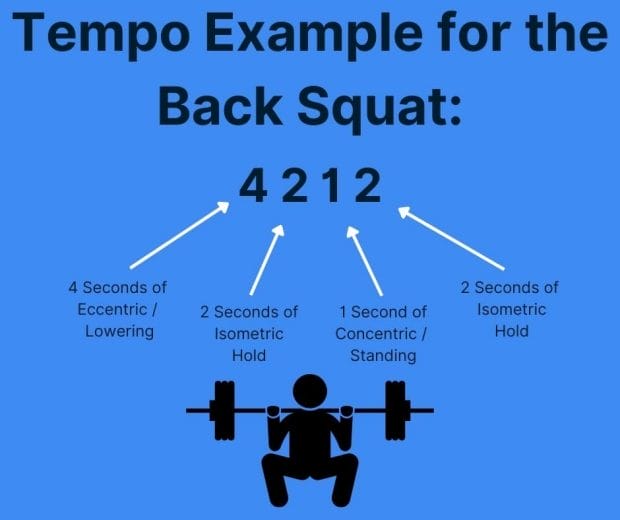There are several different parameters that you can use to modulate and progress your workouts:
- Sets
- Reps
- Load
- Movement
- Rest
- Tempo
The 6 above create an almost infinite amount of possibility for progression, thereby helping you reach your goals.
Today we’re going to cover tempo – what it is, when/how to use it, why to use it and finally – who should use it.
So what is tempo?
In the simplest terms, tempo is a 4 character directive to control the speed of a muscular contraction / movement. You’ll see it commonly written after the movement, the number of sets, and the number of reps are written out in a training design.
Like this –
Back Squat: 5 x 3 @ 4212
Or more broadly – [Movement]: [Sets] x [Reps] @ [TEMPO]
The 4212 describe the speed at which each rep of the back squat should be performed.
Tempo is always notated in this order and read left to right, like this:
- The first digit is the eccentric (or muscle lengthening) portion
- The second digit is the isometric/hold portion
- The third digit is the concentric (or muscle shortening) portion
- The fourth digit is another isometric/hold portion
So in the case of the back squat, you’d perform a 4212 tempo in the following manner:
- 4 seconds to descend
- 2 second active hold in your bottom position
- 1 second to stand up
- 2 second active hold at the top position
The third digit, which controls the concentric contraction, will sometimes have a letter there, either an ‘X’ or an ‘A.’ The ‘X’ indicates that you should complete the concentric contraction in an explosive manner, as quickly as possible. The ‘A’ would indicate that you would be receiving assistance to complete that portion of the reptition.
At this point, it’s worth mentioning that although tempo is always read in the same manner, it can be confusing for some movements that don’t traditionally start with the eccentric contraction first.
For instance, a strict pull-up and deadlift both begin by executing the concentric contraction first. Just because the eccentric/lowering phase is listed first in the tempo prescription does NOT mean that the rep starts there. You still perform the rep as normal, but just keep in mind what should be happening during each contraction.
Ex:
Strict Pull-Up – 5 x 3 @ 4212
1 second to pull chin over bar
2 second hold with chin over bar
4 seconds back to full arm lockout at bottom
2 second active hold in bottom position

Now that we’ve covered what tempo is, let’s move onto the how and when you’d employ it.
When it comes to using tempo, it’s important to understand that there are certain movements that you wouldn’t assign a tempo prescription. Here’s a short list:
- Cyclical work: like being on a rower, bike, ski erg, jumping rope, or running.
- Dynamic contractions: like olympic weightlifting, kettlebell swings, and kipping movements.
Tempo is all about controlling the speed of contraction and doing this means disrupting the natural rhythm of how contractions take place. You don’t want to do that with the above two movement categories. Isometric contractions (like plank varieties) are another example where you’d not use tempo, simply because there are not eccentric and concentric contractions to control.
The good news is that there are numerous other options (nearly anything else you can think of) for movements that can be controlled and progressed by using tempo. Variants of squats, deadlifts, pressing, and pulling. Isolation-type movements like bicep curls and tricep work. Leg extensions, back extensions, sit-ups, and hamstring curls. These are all fair game.
In terms of the length of time for each contraction type, that’s beyond the scope of this article, but much of it boils down to training age and desired outcome.
So when should you use tempo?
All the time. Why? The reality is that a tempo is always taking place (for movements where it’s appropriate), so you might as well be intentional. Why? Well that leads us to the next section.
Why Should You Use Tempo?
There are three major reasons:
- Control of the dose response / stimulus
- Think back to our squatting example above. Performing each rep as written means that every rep takes 9 seconds. Now imagine the tempo were 2111, for a total of 5 seconds per rep. While it might not seem like much for a single rep, extrapolate that out for the reps within each set. 27 seconds worth of time under tension for back squat repetitions is much different than 15 seconds worth…load not withstanding. You want to be sure that the intended dose is managed and if you don’t have a tempo written, you cannot be sure of that.
- Motor control
- If you are beginning to learn a new movement or desire to focus on a specific part of a movement, tempo is a great way to do this. For example: imagine that you are having difficulty controlling the descent in your squat and you have two people telling you how to work on it. One is saying ‘just go slower’ while the other says ‘count to 4-Mississippi while you go down.’ Which do you think will be more effective?
- Manage progression of a training design from week to week
- Tempo is a great way to make sure you are monitoring adaptation. Going back to our squatting example – if you have a 2s isometric hold at the top of each rep, but notice that in the third week of a progression you are holding at the top for 4-5 seconds each rep, that is a great insight that something is not right. Perhaps you went too heavy, the volume increase that week was too much, or even that you didn’t get enough sleep. No matter the reason, tempo can help inform and influence ongoing training design.
And finally, who is tempo for?
I hope by now you’ve seen that everyone would benefit from employing intentional tempo prescriptions.
Perhaps the better question would be: who shouldn’t use tempo? Answer: I can’t think of anyone!


